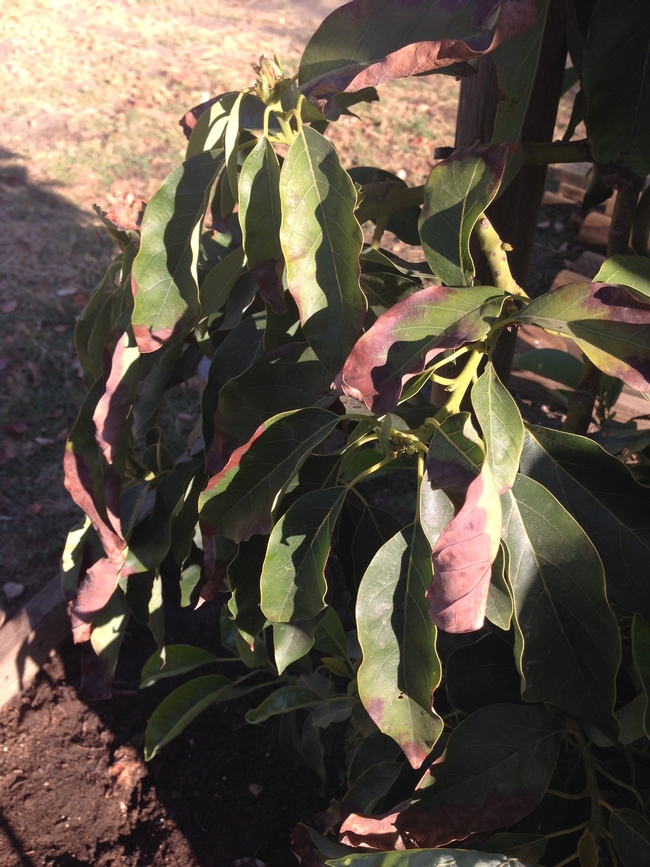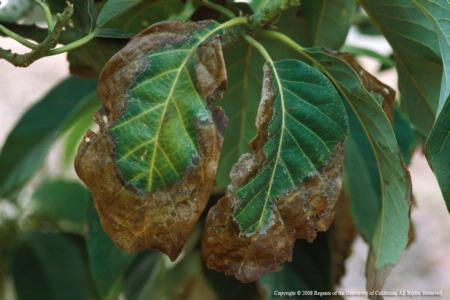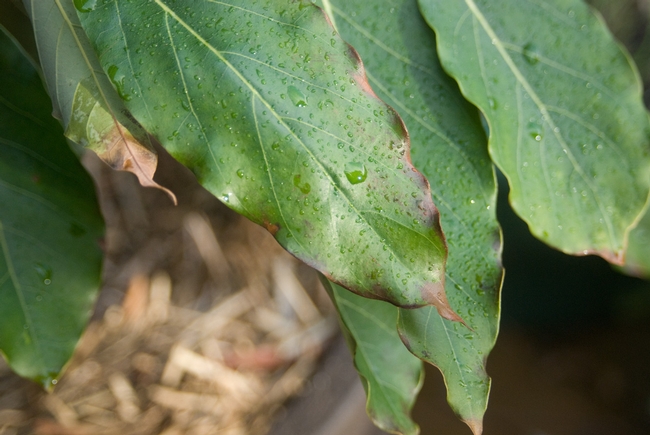Help for the Home Gardener from the CCMG Help Desk
Client's Questions and Problems:
with some webbing as well as some “corky” bark. He also said they have “red ants” on the tree which bite when handled. The container is large, and consists of a mixture of native (clay) soil and amendments. He has poor drainage in his yard hence the need for container. Has plans to plant another variety (Zutano) so will have the A and B pollinators. Varieties are compatible and appropriate for his area. Client uses well water and is close to Discovery Bay and knows about their boron problem, but his well seems fine although he has not taken a recent water test.
CCMG Help Desk Initial Response:
Thank you for calling Master Gardeners with your Avocado problems. The e-mailed photos came through well. Based upon the information so far, we think the most likely cause of the brown areas on the leaves is sunburn and/or windburn. You may have noticed that the affected leaves are mostly on the top and outside of the plant, and there are many unaffected leaves. We have had a few really hot days in recent weeks (these questions and responses are in mid-September). You can provide some temporary shade using a light shade cloth or some other shade structure on hot afternoons - although hopefully we will not have too many more of those to come this year. Also, avocados are quite sensitive to wind, so if they are in a windy area some protection from wind might help. You mentioned that the tree is getting adequate water, and from the photos I did not see problems related to well water - although it may be helpful to get that tested if you see other plants in your garden developing problems. I did see some webbing on the leaves, but it does not seem to be widespread in the tree. I could not tell from the photo if there were insects present, but it could be spider mites, and if this insect presence is only in a small area of the tree, you can wipe them off or use a quick water spray. I am including some UC links which will give some more information on pests and on avocados in general. http://ipm.ucdavis.edu/PMG/GARDEN/FRUIT/avocados.html and http://ipm.ucdavis.edu/PMG/PESTNOTES/pn7405.html
You also mentioned that you had a colony of 'red ants'. Without seeing these I cannot tell you what they are; red fire ants have been found in southern California, and I have not heard reports of them being in the Bay Area, but that does not mean you don't have them. What you are seeing could be red Spider Mites. Here is a link that might help-http://ipm.ucdavis.edu/PMG/PESTNOTES/pn7487.html
If you would like a positive identification on these ants, you could bring a sample into the Agricultural Commissioner's office, of which there is a branch in Knightsen. This link gives their hours and contact information.
http://www.co.contra-costa.ca.us/1542/Agriculture-Weights-Measures
Finally, here are some further links to general avocado culture. The second one has some good information on growing in containers. http://ucanr.org/sites/gardenweb/files/29079.pdf
and http://uccemg.com/Edible_Plants/?ds=530&uid=127
I hope this is helpful, and that you will eventually grow some good avocados.
******************************************************************
CCMG Help Desk Follow-up Response:
After we spoke earlier today, I did some research and learned that avocados are very sensitive to high salt (chloride) and boron levels in irrigation water. Symptoms of chloride toxicity include chlorosis (yellowing) of leaves and necrosis (death) of the tips and margins (edges) of leaves. Symptoms are usually more severe on the older leaves. Boron toxicity causes dark, necrotic areas along the edges of leaves.
Here is a University of California photo that shows how boron toxicity appears on an avocado (left). The right photo shows chloride toxicity effects on an avocado.

Boron Toxicity

Chloride Toxicity
The damage on the leaves in these photos look similar to those in the photos you sent previously, so it does seem possible that high levels of salt or boron in the irrigation water could be causing the leaf problems you are seeing on the tree. It is probably worthwhile for you to have the water tested for the well you are using to irrigate the tree. There is the possibility that the drought, or increased (or decreased) pumping of other nearby wells, or changed irrigation practices have affected the quality of your well water.
A list of commercial laboratories that perform water testing can be found at this link on the CCMG web page (http://ccmg.ucanr.edu/files/77177.pdf). You will want to have the water tested for irrigation suitability. It is sometimes hard to navigate the websites for the testing labs and to find a description of the services offered and the charges for the testing they can perform. You might find it easier to call the labs to get the information you need. Be sure to call several before you decide which one to use since the fees charged seem to vary quite a bit. I found a couple that charge only about $75 for the irrigation water test, but some charge twice that much.
Below is an excerpt from tables from the University of California publication entitled "Abiotic Disorders of Landscape Plants" (the original reference document's Table of Contents is at http://www.fao.org/docrep/003/T0234E/T0234E00.htm#TOC) that you might find helpful in understanding the results of your well water test. The data from the tables show maximum levels of salts (chloride) and boron in irrigation water that are generally considered safe. Because the avocado is quite sensitive to boron and salts, any amounts in your well water that are higher than the levels shown below n the table as “generally safe” could cause problems for the tree. If you have the water tested and would like some assistance in interpreting the results, you are welcome to contact us for help.
****************************************************************
Relative Boron Tolerance of Avocadoes: Sensitive @ 0.5 - 0.75 mg/l
****************************************************************
Maximum Permissible Chloride Without Avocado Leaf Injury from Different Rootstock
Root Stock Root Zone (Cle) (me/l) Irrigation Water (Clw) (me/l)
West Indian 7.5 5.0
Guatemalan 6.0 4.0
Mexican 5.0 3.3
****************************************************************
On a different topic, I looked again at the photos showing the rough, “corky” areas on the bark of the tree. It does look somewhat unusual, but I couldn't identify any likely causes. When I tried to enlarge the photo to look closer at the corky areas, the photo became blurry. If you want us to investigate further, perhaps you could send us a “close-up” photo. Also, one possibility that occurred to me is that it might be sun scald. You might want to check to determine whether the side of the tree that receives the most direct sunlight shows more of the rough corky areas as compared to more shaded areas. If the answer is “yes”, it could point to sun scald.
Hope you find this additional information to be helpful. Feel free to call us again if you have additional questions.
******************************************************************
Contra Costa Master Gardeners' Help Desk
Editor's Note: The Contra Costa Master Gardener Help Desk is available year-round to answer your gardening questions. Except for a few holidays, we're open every week, Monday through Thursday from 9:00 am to Noon at 75 Santa Barbara Road, 2d Floor, Pleasant Hill, CA 94523.
We can also be reached via telephone: (925) 646-6586, email: ccmg@ucanr.edu, and we are on the web at http://ccmg.ucanr.edu/